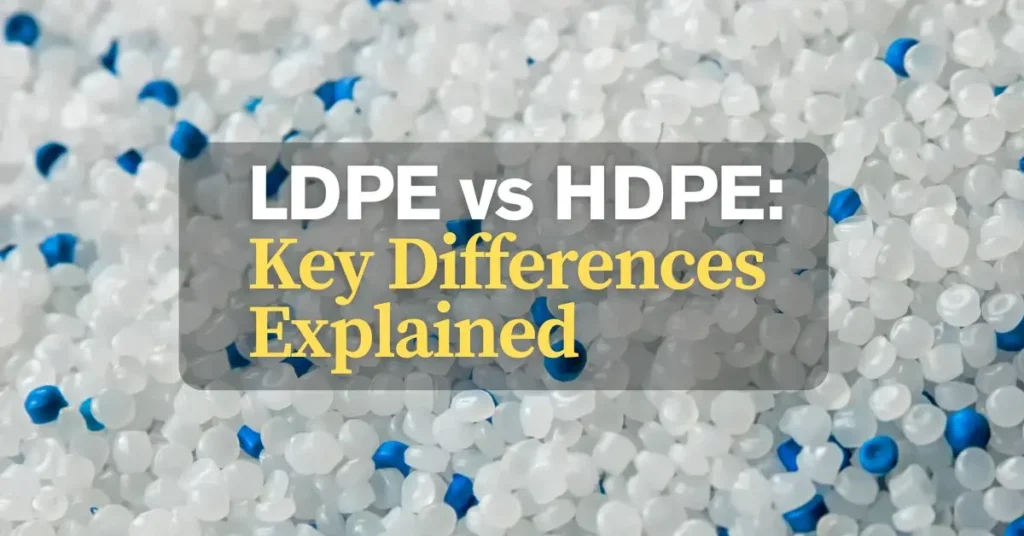
Ever wondered about the plastic stuff all around us? Like, why some plastic bottles feel super stiff and others are kind of squishy? Well, a lot of that comes down to two main types: HDPE and LDPE. These are both kinds of polyethylene, but they’re made a bit differently, and that makes all the differences between hdpe and ldpe. Let’s break down what makes each one unique, what they’re used for, and how they stack up.
Key Takeaways
- HDPE is strong and rigid, good for things like milk jugs and pipes.
- LDPE is flexible and soft, used for plastic bags and films.
- Their molecular structures are different, which changes how they feel and work.
- HDPE is generally easier to recycle than LDPE.
- Picking between them depends on what you need the material to do.
Understanding High-Density Polyethylene (HDPE)
Let’s talk about HDPE. You see it everywhere, but have you ever stopped to think about what it actually is? High-Density Polyethylene is a super versatile plastic, and it’s way more than just milk jugs. It’s in everything from pipes to playground equipment, and for good reason. It’s tough, it’s durable, and it’s surprisingly resistant to a lot of things that would ruin other materials. Let’s break down what makes HDPE so special.
Defining HDPE Characteristics
So, what exactly is HDPE? Well, it’s a thermoplastic polymer made from petroleum. The “high-density” part means the polyethylene chains are packed together pretty tightly. This tight packing is what gives HDPE its strength and rigidity. Think of it like this: it’s like packing a suitcase really carefully versus just throwing everything in. The carefully packed suitcase (HDPE) is going to be much sturdier. It also has a high strength-to-weight ratio, making it ideal for applications where weight matters. You can find more information about its strength and durability online.
Manufacturing Process of HDPE
Okay, so how do they actually make HDPE? It starts with ethylene gas, which is derived from petroleum or natural gas. This gas goes through a polymerization process, usually using a catalyst. There are a few different methods, like slurry polymerization, solution polymerization, and gas-phase polymerization. Each method has its own advantages, but the end result is the same: long chains of polyethylene molecules. After polymerization, the HDPE is processed into pellets, which can then be melted and molded into all sorts of shapes.
Key Properties of HDPE

Here’s where HDPE really shines. It’s got a bunch of properties that make it awesome for a wide range of uses:
- High Strength and Rigidity: It can handle a lot of stress without breaking or deforming.
- Chemical Resistance: It’s resistant to many solvents, acids, and bases, making it great for containers that hold chemicals.
- Low Moisture Absorption: It doesn’t absorb water easily, which is why it’s used in outdoor applications and for containers that hold liquids.
- Impact Resistance: It can withstand impacts without cracking or shattering.
- Recyclability: HDPE is recyclable, which is a big plus for the environment.
HDPE’s combination of strength, chemical resistance, and ease of processing makes it a go-to material for countless applications. It’s a workhorse plastic that’s essential to modern life.
Here’s a quick look at some key properties:
| Property | Value |
|---|---|
| Density | 0.941 to 0.965 g/cm³ |
| Tensile Strength | 22 to 35 MPa |
| Melting Point | 120 to 140 °C |
| Chemical Resistance | Excellent to most acids and bases |
Exploring Low-Density Polyethylene (LDPE)
Defining LDPE Characteristics
Low-Density Polyethylene, or LDPE, is a type of polyethylene known for its flexibility and clarity. It’s made through a high-pressure polymerization process, which results in a polymer with significant branching. This branching prevents the polymer chains from packing tightly, leading to its lower density compared to HDPE. LDPE is also known for its ease of processing, making it a popular choice for various applications.
Manufacturing Process of LDPE
The manufacturing of LDPE typically involves a high-pressure process using free-radical polymerization. Ethylene gas is subjected to extremely high pressures (ranging from 10,000 to 50,000 psi) and high temperatures (80-120°C) in the presence of an initiator, such as an organic peroxide. This process causes the ethylene molecules to link together, forming long, branched chains of polyethylene. The resulting polymer is then cooled, pelletized, and ready for use in manufacturing various products. The LDPE manufacturing process is quite energy-intensive due to the high pressures required.
Key Properties of LDPE
LDPE possesses a unique set of properties that make it suitable for a wide range of applications. These include:
- Flexibility: LDPE is highly flexible, making it ideal for applications requiring bending or stretching.
- Transparency: It has good clarity, allowing for easy visibility of the contents within packaging.
- Chemical Resistance: LDPE offers good resistance to many chemicals, protecting contents from corrosion.
- Water Resistance: It is highly resistant to water, making it suitable for moisture-barrier applications.
LDPE’s lower density and branching result in a lower tensile strength and temperature resistance compared to HDPE. However, its flexibility and ease of processing often make it the preferred choice for applications where these properties are more important than strength or heat resistance.
Structural Differences Between HDPE and LDPE
Molecular Structure and Density
Okay, so let’s get into the nitty-gritty of what makes HDPE and LDPE different at a molecular level. It all boils down to their structure. HDPE has a linear structure with minimal branching, which allows the molecules to pack together tightly. This tight packing is what gives it that high density we keep hearing about. Think of it like neatly stacked boxes. On the other hand, LDPE has significantly more branching. These branches prevent the molecules from packing as closely, resulting in a lower density. Imagine those boxes scattered all over the place – less organized, less dense.
Impact on Material Properties
This difference in molecular structure has a huge impact on the properties of each material. Because HDPE molecules are so tightly packed, it’s stronger, more rigid, and has a higher melting point than LDPE. It’s also more resistant to chemicals. LDPE, with its looser structure, is more flexible and has better impact resistance, especially at lower temperatures. It’s also more transparent than HDPE. Think of it this way: HDPE is like a sturdy, reliable workhorse, while LDPE is more like a flexible, adaptable acrobat. The material differences are significant.
Resulting Applications
Because of these different properties, HDPE and LDPE end up being used in very different applications. HDPE’s strength and chemical resistance make it ideal for things like milk jugs, detergent bottles, and even pipes. Its rigidity is a plus in these scenarios. LDPE’s flexibility and impact resistance make it a good choice for plastic films, grocery bags, and squeeze bottles. It’s all about matching the material’s properties to the job at hand.
It’s important to remember that while both are polyethylene plastics, their structural differences dictate their performance and suitability for various applications. Choosing the right one depends entirely on what you need the plastic to do.
Performance Variations: HDPE Versus LDPE
Strength and Durability Comparisons
When it comes to strength, HDPE definitely takes the lead. It’s more rigid and has a higher tensile strength than LDPE, meaning it can withstand more force before breaking or deforming. Think of it this way: HDPE is like the sturdy workhorse, while LDPE is more like the flexible helper. This difference stems from their molecular structures; HDPE’s tightly packed chains give it superior strength. LDPE, with its branched structure, is more prone to stretching and tearing under stress. For applications needing robust materials, HDPE is preferred.
Flexibility and Impact Resistance
LDPE shines when flexibility is key. It’s much more pliable than HDPE, making it ideal for applications where bending and conforming are necessary. However, this flexibility comes at a cost: LDPE isn’t as impact-resistant as HDPE. While it can absorb some impact, it’s more likely to puncture or tear under sharp blows. HDPE, on the other hand, can take a beating without showing much damage. It’s the go-to choice for items that need to withstand rough handling or potential impacts. Consider the difference between a flexible plastic bag (LDPE) and a rigid milk jug (HDPE) – you get the idea.
Chemical and Temperature Resistance
Both HDPE and LDPE offer good chemical resistance, but HDPE generally holds up better against a wider range of chemicals. It’s less likely to react or degrade when exposed to harsh substances, making it suitable for containers that store cleaning supplies or other chemicals. Temperature-wise, HDPE also has a slight edge. It can withstand higher temperatures without softening or deforming compared to LDPE. This makes it a better choice for applications where the material might be exposed to heat, like some types of piping or containers for hot liquids. Chemical resistance is a key factor in material selection.
Choosing between HDPE and LDPE often comes down to understanding the specific demands of the application. If you need something strong and resistant to chemicals and impacts, HDPE is your best bet. But if flexibility and conformability are more important, LDPE is the way to go. It’s all about matching the material’s properties to the task at hand.
Applications and Uses of HDPE and LDPE

Common Uses of HDPE
HDPE, or High-Density Polyethylene, is a workhorse in the plastics world, and you see it everywhere. Its strength and chemical resistance make it ideal for a ton of different applications.
- Milk jugs and detergent bottles: These need to be sturdy and able to hold liquids without leaking or reacting with the contents.
- Pipes: HDPE pipes are used for water and gas lines because they don’t corrode and can last for ages.
- Plastic lumber: Great for outdoor furniture because it doesn’t rot or splinter.
HDPE is favored over other materials because of its high strength-to-weight ratio, excellent chemical resistance, and durability. It’s also easily molded and recyclable, making it a sustainable choice.
Common Uses of LDPE
LDPE, or Low-Density Polyethylene, is the flexible friend of the plastic family. It’s not as strong as HDPE, but its flexibility makes it perfect for other things. LDPE is used in a variety of applications.
- Plastic bags: Think grocery bags, trash bags, and the bags your dry cleaning comes in.
- Film wrap: Used for food packaging and shrink wrap.
- Squeeze bottles: Like those for honey or mustard.
Industry-Specific Applications
Both HDPE and LDPE have found niches in various industries, each leveraging the unique properties of the plastic. HDPE is a preferred material for water and gas distribution pipes due to its durability and long lifespan. Its resistance to chemicals ensures these pipes won’t corrode when transporting various substances. The ease of installation reduces labor time and costs, making it a cost-effective solution for large-scale infrastructure projects. It is also used in sewage mains and natural gas distribution systems, where its reliability is crucial for public safety.
LDPE is commonly used in agricultural films to protect crops and in the apparel industry for poly mailers.
| Industry | HDPE Applications
Environmental Impact and Recyclability
Recycling Processes for HDPE
HDPE, or high-density polyethylene, is one of the more commonly recycled plastics out there. The recycling process for HDPE usually starts with collection, where used HDPE products are gathered from recycling bins and drop-off locations. Then, these items are taken to a recycling facility where they’re sorted to remove any contaminants, like labels or leftover food. After sorting, the HDPE is shredded into small flakes. These flakes are then cleaned and melted down. Finally, the molten plastic is formed into new products, such as bottles, containers, or even plastic lumber. The ease of recycling HDPE makes it a more environmentally friendly choice compared to some other plastics.
Recycling Processes for LDPE
LDPE, or low-density polyethylene, presents a bit more of a challenge when it comes to recycling. While technically recyclable, LDPE isn’t as widely recycled as HDPE. The process is similar: collection, sorting, shredding, cleaning, and melting. However, because LDPE is often used in films and flexible packaging, it can be more difficult to sort and process. Also, the demand for recycled LDPE isn’t always as high, which can limit its recyclability. Despite these challenges, some facilities are equipped to handle LDPE, turning it into items like trash can liners, compost bins, and landscaping materials.
Sustainability Considerations
When we talk about the sustainability of HDPE and LDPE, there are a few things to keep in mind. Both materials are derived from petroleum, a non-renewable resource, so their production contributes to fossil fuel consumption. However, recycling these plastics can help reduce our reliance on virgin materials and lower greenhouse gas emissions. Plus, the durability of HDPE means that products made from it can have a longer lifespan, reducing the need for frequent replacements. On the other hand, LDPE’s flexibility makes it ideal for certain applications, but its lower recycling rate can be a concern. Ultimately, choosing the right material depends on the specific application and a careful consideration of its environmental impact. Here are some points to consider:
- The energy required for production and recycling.
- The potential for litter and pollution.
- The availability of recycling infrastructure.
It’s important to remember that recycling is just one piece of the puzzle. Reducing consumption, reusing products whenever possible, and supporting companies that prioritize sustainable practices are all essential steps towards a more environmentally responsible future. We should also consider the environmental impact of plastic production.
Cost and Production Efficiency
Production Costs of HDPE
When we talk about HDPE, it’s good to know that its production often involves slightly more complex processes compared to LDPE. This can translate to higher initial setup costs for manufacturing plants. However, HDPE’s efficient use of raw materials and faster processing cycles can offset some of these costs in the long run.
- Catalyst types used in HDPE production can be more expensive.
- HDPE’s higher processing temperatures might increase energy consumption.
- The density of HDPE allows for more product per unit of raw material.
Production Costs of LDPE
LDPE production generally benefits from simpler manufacturing processes. This can lead to lower initial investment costs for equipment and facilities. LDPE’s production is more forgiving, which can reduce waste and improve overall efficiency.
- Lower processing temperatures reduce energy consumption.
- Simpler equipment designs translate to lower maintenance costs.
- LDPE production can be adapted to a wider range of manufacturing setups.
Market Availability and Pricing
Both HDPE and LDPE are widely available, but their prices can fluctuate based on several factors. These include crude oil prices, production volumes, and market demand. Generally, LDPE might be slightly cheaper than HDPE, but this isn’t always the case. Keep an eye on market trends to make the most informed decision.
- Crude oil prices directly impact polyethylene costs.
- Global supply chain disruptions can affect availability and pricing.
- Recycled content can influence the price of both materials.
Understanding the cost implications of each material is important. Consider the long-term benefits, such as durability and recyclability, when evaluating the overall value. Don’t just focus on the initial price tag; think about the total cost of ownership.
Choosing the Right Polyethylene for Your Needs
Factors Influencing Material Selection
Choosing between HDPE and LDPE isn’t always straightforward. It really depends on what you need the plastic for. Think about the environment it’ll be in, what kind of stress it will endure, and what properties are most important. Consider the application’s demands first and foremost.
- Required strength and rigidity
- Flexibility needs
- Chemical exposure
- Temperature range
Specific Project Requirements
Each project has its own unique set of needs. For example, if you’re making a container that needs to hold chemicals, HDPE’s chemical resistance is a big plus. But if you need a flexible film for wrapping food, LDPE might be the better choice. It’s all about matching the material’s properties to the job at hand. Here’s a quick guide:
| Requirement | HDPE | LDPE |
|---|---|---|
| High Strength | Excellent | Poor |
| Flexibility | Poor | Excellent |
| Chemical Resistance | Good | Fair |
| Temperature Range | Higher | Lower |
| Impact Resistance | Good | Fair |
| Cost | Generally Lower | Generally Higher |
Future Trends in Polyethylene Use
The world of polyethylene is constantly evolving. There’s a big push towards more sustainable options, like bio-based polyethylene and improved recycling technologies. We’re also seeing advancements in material science that are creating new types of polyethylene with enhanced properties. Expect to see more innovation in this space as we strive for a more circular economy.
As environmental concerns grow, expect to see more focus on developing biodegradable polyethylene alternatives and improving recycling infrastructure. This will likely influence material selection in the future, with sustainability becoming an increasingly important factor.
Conclusion
So, we’ve gone through a lot about HDPE and LDPE. It’s pretty clear they’re both types of plastic, but they’re really different in how they act and what they’re good for. HDPE is tough and stiff, great for things like milk jugs or pipes. LDPE, on the other hand, is more flexible and soft, which makes it perfect for plastic bags and wraps. Knowing these differences helps you pick the right one for whatever you’re making or using. It’s not just about plastic; it’s about picking the right tool for the job.
Frequently Asked Questions
What exactly is HDPE?
High-Density Polyethylene, or HDPE, is a tough type of plastic made from petroleum. It has long chains of molecules packed tightly together, making it very strong and stiff. It’s used for things like milk jugs, pipes, and sturdy containers because it’s so durable and can handle different chemicals.
What is LDPE?
Low-Density Polyethylene, or LDPE, is also a plastic from petroleum, but its molecules are branched, so they don’t pack together as tightly. This makes LDPE much more flexible and softer than HDPE. You’ll find it in plastic bags, squeeze bottles, and cling wrap.
What’s the big difference between HDPE and LDPE?
The main difference is how their molecules are arranged. HDPE has very straight, tightly packed molecules, which makes it dense, strong, and rigid. LDPE has branched molecules that are loosely packed, making it less dense, more flexible, and softer. Think of HDPE as a sturdy milk jug and LDPE as a soft plastic shopping bag.
Where are HDPE and LDPE typically used?
HDPE is super strong and resistant to chemicals, so it’s great for things that need to hold up, like pipes, outdoor furniture, and bottles for cleaning products. LDPE, being flexible and soft, is perfect for items that need to bend or stretch, such as plastic films, grocery bags, and lids.
Can HDPE and LDPE be recycled?
Yes, both HDPE and LDPE are recyclable! They are often collected separately from other plastics. HDPE is usually recycled into new bottles, pipes, and even plastic lumber. LDPE can be turned into new bags, films, and various other products. Recycling these plastics helps reduce waste and saves resources.
How do I know which one to use for my project?
Choosing between HDPE and LDPE depends on what you need the material to do. If you need something stiff, strong, and resistant to chemicals, like a water pipe or a sturdy container, go with HDPE. If you need something flexible, soft, and easy to squeeze, like a plastic bag or a flexible lid, LDPE is the better choice.
